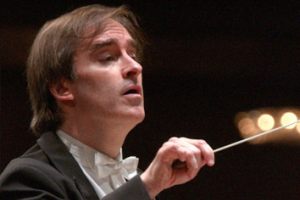
the Mtsenk District at our peril
Conlon, in the best audience outreach in a San Francisco Symphony subscription concert I have ever witnessed, gave an advance, blow-by-blow description of the action that Shostakovich’s music accompanies when staged in the opera house. The result managed to move Mtsensk to Managua, because the audience went bananas.
The importance of what Conlon accomplished, from an educational standpoint, cannot be overstated. His introduction to his suite was not a rambling, off-the-cuff chat, or the all-too-common awkward interview involving a third party. No, this was an evidently rehearsed, entertaining monologue with no fewer than 13 short excerpts of the 43-minute suite that Conlon had arranged from the opera score, played live by the orchestra. Nor was this a preconcert, optional bonus for patrons with nothing better to do than arrive early — no, it began after intermission, lasted a quarter of an hour, and was planned as an integral part of the concert.

Success in Excess
Shostakovich’s opera music does not ingratiate. The 24-year-old composer constructs a musical environment that succeeds in excess. The brutality, degeneracy, corruption, and intoxication of all characters other than the antiheroine, Lady Katerina Ismailova, are subjected to such over-the-top musical treatments that the more conventional depictions of her two murders and adulterous desires seem like pastorales by comparison. Shostakovich’s skill at orchestrating parody, satire, diabolical irony, tub-thumping stupidity, and craven brutality are nowhere in better evidence. The many climaxes (including a famous sexual one) in Colon’s arrangement are noisy, deliberately crude — and ultimately transfixing. Conlon must be praised for constructing a powerful suite that allows listeners to focus on the musical achievement alone, so as to better appreciate the dramatic achievement to be had on stage or via DVD.Still, to claim, as Conlon does, that “Lady Macbeth is one of the 20th century’s greatest operas” may be going too far. The music is directed solely at the human beast and never at the best. The titular murderer in Alban Berg’s Wozzeck is far more sympathetic that Katerina, the music far more moving. The same could be said for Peter Grimes in Benjamin Britten’s great opera bearing that name. Musically, the melodic and motivic memorability of Shostakovich’s later works is largely absent from this early work. Also, his indebtedness to Gustav Mahler is rather too evident in his use of the harp and succeeding major-minor triads. For all Lady Macbeth’s power, its overarching nastiness leaves the bitter taste of a deadly mushroom, one even more toxic if the political interpretation of the Russian scholar Richard Taruskin is considered:
Shostakovich had turned [Leskov’s] tale into one of class warfare. Katerina’s victims were class enemies, creatures at a lower stage of historical development than she, and she had every right, according to the objective laws of historical materialism, to eliminate them.
Was this why the opera enjoyed 83 performances before Stalin saw it in 1936? Possibly offended by its dissonance and sexual explicitness, Stalin then engineered the infamous Pravda editorial that banned the opera and made Shostakovich temporarily both persona non grata and fearful for his life. But as Taruskin rightly pointed out in 1997, the sympathy we feel for Shostakovich the victim of totalitarianism and his subsequent work may be misplaced when it comes to the essence of Lady Macbeth:
It could be argued that its martyrdom humanized its creator. And yet it remains a profoundly inhumane work of art. Its technique of dehumanizing victims is the perennial method of those who would perpetuate and justify genocide. ... In the liberal West we are opposed in principle to banning works of art. ... Yet if we believe that is so because an opera cannot threaten life and morals, then perhaps we are more vulnerable to the dehumanizing message of this opera, one of our ghastly century’s greatest and ghastliest. If it is because we believe ethics can have no bearing on aesthetics, then our own dehumanization is already far advanced.
Beast for 10 Fingers
The first half of this San Francisco Symphony concert, after an eight-minute romp with Hector Berlioz’ Le Corsaire Overture, was devoted to music for a species referred to in Saint-Saëns’ Carnival of the Animals as “wild asses” — virtuoso pianists. The vehicle was the second concerto written by one of the (initially) wildest of them all, Franz Liszt, who wrote it when he was 27 and revised it four times over some two decades. There is a good reason he wasn’t satisfied: The piece is a series of sometimes beautiful, sometimes stirring episodes that cohere (barely) thanks to the baling wire of rondo-like repetitions and breathtaking intersectional cadenzas.Metaphorically cognizant of the piebald texture of the composition he was about to drive, pianist Jean-Yves Thibaudet suited up for his run in what looked like dark wool or gabardine concert attire festooned with angular, asymmetrically arranged, black satin patches. Looking every inch the stereoptypic scale-smasher, Thibaudet wowed the audience with flashy technique and Romantic posturings, but his rendition of this technical beast of a piece was not the best I’ve heard. There were inaccuracies of execution, and an infelicitous handling of the difficult left-hand appoggiaturas in the first D-minor section. Somehow, though I may be imagining things, a lack of sincerity was projected, a feeling I did not get by watching Conlon’s excellent conducting.
For its part, the orchestra played splendidly, though it barely managed to emerge unscathed from the difficult woodwind parts at the opening of Le Corsaire, so brisk was Conlon’s tempo. I suppose it was possible to get away with errors here and there for quieter instruments in the blast zones of the Shostakovich, but all sounded fine to me. It must have sounded great to orchestra members as well, for they applauded Conlon vigorously at the end of the evening, along with a mostly standing audience.

